
A two dimensional MHD Natural Convection and mass transfer flow past an inclined semi-infinite vertical flat plate in the presence of heat generation and porous medium has been studied. An uniform magnetic field is applied normal to the plate. Exact solutions are obtained for concentration, temperature and velocity in terms of exponential functions. The numerical results are presented graphically for different values of the parameters. Finally, the numerical values of the local skin friction coefficient, local Nusselt Number and Sherwood number are shown in a table.
The study of convective flows with heat and mass transfer in a porous medium has attracted considerable attention in recent time due to numerous application in geothermal energy, oil reservoir modelling, building insulation, food processing and grain storage. Bhuvaneswari et.al[3] presented an analytical solution for the problem of convection heat and mass transfer of a viscous electrically conducting incompressible fluid over a semi-infinite inclined plate in a porous medium with radiation and heat generation.
Bala Anki Reddy [2] studied the effects of radiation on a steady combined free – forced convective and mass transfer flow of a viscous incompressible electrically conducting and radiating fluid over an isothermal semi-infinite vertical porous flat plate embedded in a porous medium. Ahmmed et.al [1] considered a two-dimensional natural convection flow of a viscous incompressible and electrically conducting fluid past a vertical impermeable flat plate is considered in presence of a uniform transverse magnetic field. In this paper we have considered Hall current effects on MHD natural Convection flow of viscous incompressible fluid past an inclined vertical flat plate in a porous medium. Harikrishan et.al[4] discussed an unsteady free convective flow past an infinite vertical porous plate with heat sink under Hall current effects.
Consider a steady two dimensional laminar free convection boundary layer flow of a viscous incompressible, electrically conducting fluid past a semi-infinite inclined porous plate with an acute angle to the vertical. The flow is assumed to be in the x-direction which is taken along the semi-infinite inclined porous plate and y-axis normal to it. A magnetic field of uniform strength Bo is introduced normal to the direction of the flow. Then under the usual Boussineq's and boundary layer approximations, the general equations are
Equation of continuity

Equation of Motion

Equation of Energy

Equation of Mass

with the boundary conditions

Where u, v is the velocity components associated with the direction of increase of coordinates x and y measured along and normal to the vertical plate. T is the temperature of the fluid in the boundary layer, g is the acceleration due to gravity, β is the coefficients of thermal expansion, κ is the thermal conductivity, ρ∞ is the density of the fluid, Cp is the specific heat at constant pressure and T∞ is the temperature of the ambient fluid and ν the kineamtics viscosity of the fluid.
We now introduce the following non-dimensional quantities

Using the above non-dimensional quantities the equations (1) to (4) reduces to



Where M is the Hartmann number, m is the Hall parameter, Gr is the thermal Grashoff number, Gc is the mass Grashoff number, Pr is the Prandtl number, Sc is the Schmidt number, α is the angle of inclination, θ is the dimensionless temperature and Ф is the dimensionless concentration
With the boundary conditions.

The equation (7) to (9) with the boundary conditions (10) are simple ordinary differential equation. We can find the solution of that equation (7) to (9) as the following form equation (11) to (13).



The skin friction, Nusselt number and Sherwood number are expressed as
The local skin friction.

The local Nusselt Number

The local Sherwood number





The velocity of the fluid thus obtained are discussed through graphically for various parameters like the Hartmann number M, Hall parameter m, permeability parameter k, Prandtl number Pr, Thermal Grashoff number Gr, Mass Grashoff number Gc, Schmdit number Sc, angle of the inclination α.
In Figure 1 we noticed that the reversal flow, for various values of parameter and for Gr = -10, when the Hartmann number is increasing, the fluid velocity is increasing near y = 2.5 and rapidly decreases. Figures 2, 3 and 5 shows that the fluid velocity increasing for increasing the hall parameter, porasitic parameter and mass Grashoff number respectively.

Figure 1. The variation of velocity for various values m=0.1, k=1, Gr=-10, Pr=0.72, Gc=3, Sc=0.22, α = π/6

Figure 2. The variation of velocity for various values M=1.5, k=1, Gr=5, Pr=0.72, Gc=3, Sc=0.22, α= π/6
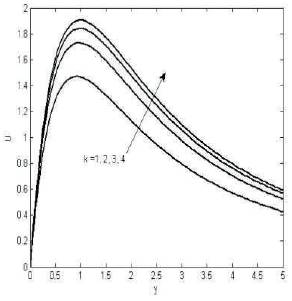
Figure 3. The variation of velocity for various values M=1.5, m=0.1, Gr=5, Pr=0.72, Gc=3, Sc=0.22, α = π/6
Figures 4 and 6 shows that the fluid velocity is increases for increasing the Prandtl number, Schmidt number. Figure 7 that the velocity decreases for increasing the angle of inclination. Figure 8 shows that the temperature decreases for increasing Prandtl number and Figure 9 shows that the concentration decreases for increasing Schmidt number.
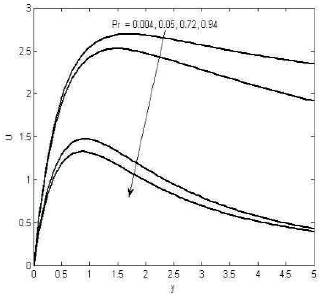
Figure 4. The variation of velocity for various values M=1.5, m=0.1, k=1, Gr=5, Gc=3, Sc=0.22, α= π/6
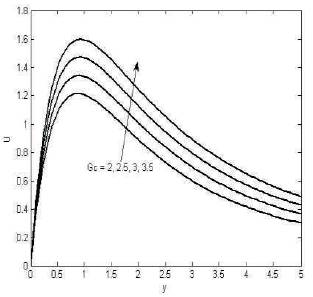
Figure 5. The variation of velocity for various values M=1.5, m=0.1, k=1, Gr=5, Pr=0.72, Sc=0.22, α = π/6
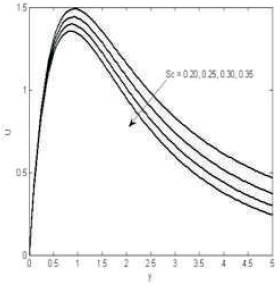
Figure 6. The variation of velocity for various values M=1.5, m=0.1, k=1, Gr=5, Pr=0.72, Gc=3, Sc=0.22, α = π/6

Figure 7. The variation of velocity for various values M=1.5, m=0.1, k=1, Gr=5, Pr=0.72, Gc=3, Sc=0.22
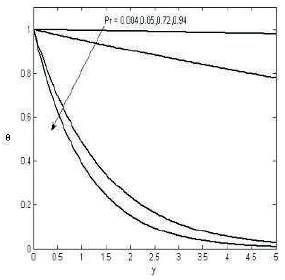
Figure 8. The variation of temperature profiles
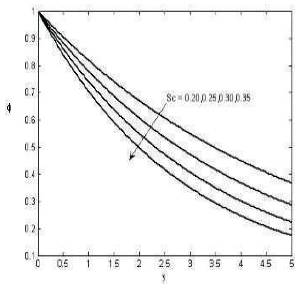
Figure 9. The variation of mass profiles
Finally the following may be concluded throughout the present investigations.